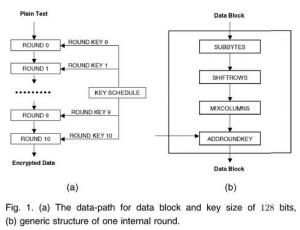EncryptionEncryption prevents FBI from cracking San Bernardino attackers’ phone
U.S. law enforcement agencies have been unable to access a telephone used by the two Islamist attackers in the San Bernardino shooting, FBI director James Comey said Tuesday. Comey stressed that the post-Snowden end-to-end encryption some technology companies are now offering their customers make it impossible for law enforcement to learn more about terrorists and criminal networks, even after terrorist or criminal acts have been committed and even if a court has approved access to the information.

AES encryption process in rounds // Source: umass.edu
U.S. law enforcement agencies have been unable to access a telephone used by the two Islamist attackers in the San Bernardino shooting, FBI director James Comey said Tuesday.
Comey stressed that the post-Snowden end-to-end encryption some technology companies are now offering their customers make it impossible for law enforcement to learn more about terrorists and criminal networks, even after terrorist or criminal acts have been committed and even if a court has approved access to the information.
The BBC reports that Comey was briefing lawmakers on emerging threats, and used the example of the San Bernardino terrorists to underline the U.S. government’s concerns about the strength of commercially available encryption.
“It affects our counterterrorism work,” he told lawmakers.
“In San Bernardino, a very important investigation to us, we still have one of those killers’ phones that we’ve not been able to open. It’s been over two months now and we’re still working on it.”
Since the 2 December 2 2015 attack by Syed Farook and his Pakistani wife Tashfeen Malik, the FBI and the U.S. intelligence community have been trying to figure out whether the couple were self-radicalized and acted alone, or whether they were part of a broader Islamist groups or individuals in the United States or abroad.
The end-to-end encryption with which the couple’s phone was equipped has made it impossible for the FBI and other agencies to answer that question. Without learning more about the couple’s network, if one exists, it would be impossible to pick up other members of such network.
The FBI has encountered the same problem in trying to learn more about the terrorists who tried to shoot out an anti-Mohammed art exhibit in Garland, Texas last May. The phone found on the terrorist’s body showed that he made more than 100 phone calls and exchanged text messages in the hours before the attack – but the FBI has been unable to crack the encryption to learn more about the attacker’s network and else was a part of it.
James Clapper, the director of U.S. national intelligence, echoed Comey’s arguments. “Those devices are going to hold the evidence of child pornography, communications that someone made before they were killed, before they went missing,” Clapper said, describing phones with a default lock.
“So it is a big problem with law enforcement armed with a search warrant when you find a device that can’t be opened even though the judge said there’s probable cause to open it.”
